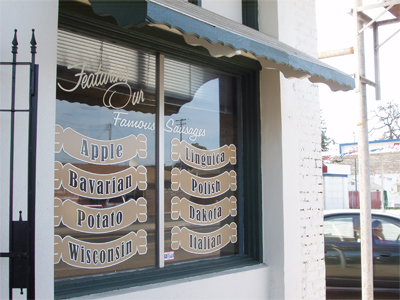HISTORY of SAUSAGES
&
WHERE TO GO TO BUY
The first things you need to do is find a local meat market which will provide you with delicious sausages.
Yesterday I traveled to one of my favorite stores.
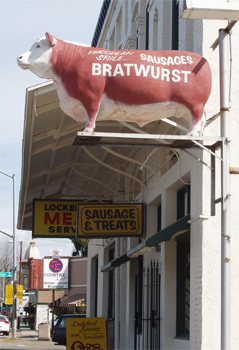
Victor Sausage,
Victor, California, USA
found on highway 12
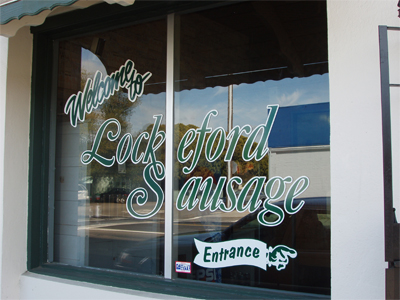
| As you can see from the widow sign it doesn't just have German sausages. |
|
CLASSIFICATIONS OF SAUSAGES AROUND THE WORLD
WIKIPEDIA : http://en.wikipedia.org/wiki/Sausage#History
>>Sausages may be classified in any number of ways, for instance by the type of meat and other ingredients they contain, or by their consistency. The most popular classification is probably by type of preparation, but even this suffers from regional differences in opinion. In the English-speaking world, the following distinction between fresh sausages, cooked sausages and dry sausages seems to be more or less accepted:
* Cooked sausages are made with fresh meats and then fully cooked. They are either eaten immediately after cooking or must be refrigerated. Examples include Braunschweiger and liver sausages.
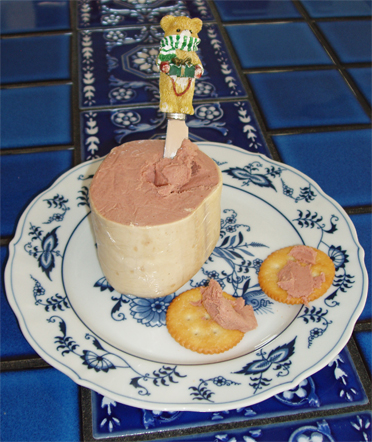
Liverwurst on Ritz crackes
* Cooked smoked sausages are cooked and then smoked or smoke-cooked. They are eaten hot or cold, but need to be refrigerated. Examples include Hot dogs, kielbasa and Mortadella.
* Fresh sausages are made from meats that have not been previously cured. They must be refrigerated and thoroughly cooked before eating. Examples include Boerewors, Italian pork sausage and fresh beef sausage.
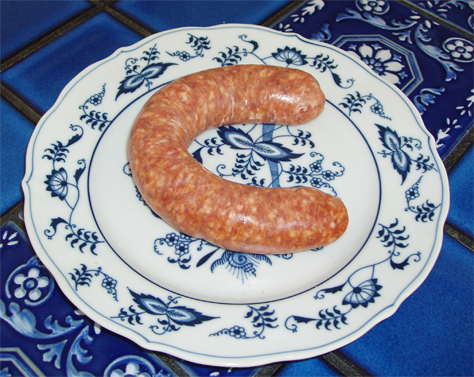
Uncooked (Fresh) Dakota Bratwurst
* Fresh smoked sausages are fresh sausages that are smoked. They should be refrigerated and cooked thoroughly before eating. Examples include Mettwurst and Romanian sausage.
* Dry sausages are fresh sausages that are dried. They are generally eaten cold and will keep for a long time. Examples include salami, Droë wors and summer sausage.
- http://www.sausagelinks.co.uk/facts_flavours.asp :Def. of dry sausage, also, known as "summer sausage" (because it can be kept in warm weather without refrigeration) and seminary sausage (because it is associated with the type of sausages made at monasteries), made from cured sausage that is air-dried under controlled time temperature-humidity conditions. They may or may not be smoked. Lebanon bologna, salami, kosher sausage, and Spanish chorizo are examples of such sausages.
Other countries, however, use different systems of classification. Germany, for instance, which boasts more than 1200 types of sausage, distinguishes raw, cooked and pre-cooked sausages.
* Raw sausages are made with raw meat and are not cooked. They are preserved by lactic fermentation, and may be dried, brined or smoked. Most raw sausages will keep for a long time. Examples include cervelat, mettwurst and salami.
* Cooked sausages may include water and emulsifiers and are always cooked. They will not keep long. Examples include Jagdwurst and Weißwurst.
* Pre-cooked sausages are made with cooked meat, and may include raw organ meat. They may be heated after casing, and will keep only for a few days. Examples include Saumagen and Blutwurst.
Germany is known for being one of the major sausage producers of the world from which the frankfurter originated as well as various lesser known ones such as bierwurst.
The US has a particular type called pickled sausages, commonly found in gas stations and small roadside delicatessens. These are usually smoked and/or boiled sausages of a highly processed frankfurter (hot dog) or kielbasa style plunged into a boiling brine of vinegar, salt, spices (red pepper, paprika...) and often a pink coloring, then jarred. They are available in single blister packs i.e. Slim Jim meat snacks, or in jars atop the deli cooler. They are shelf stable, and are a frequently offered alternative to beef jerky, beef stick, and kippered beef snacks.
Certain countries classify sausage types according to the region in which the sausage was traditionally produced:
* France: Montbéliard, Morteau, Strasbourg, Toulouse, ...
* Germany: Frankfurt, Thuringia, Nuremberg, Pomerania, ...
* Austria: Vienna, ...
* South Tyrol, Italy: Meran
* England: Cumberland, Chiltern, Lincolnshire
* Slovenia: Kranjska (klobasa), after the Slovenian name for the province of Carniola
* Spain: botifarra catalana, chorizo riojano, chorizo gallego, chorizo de Teror, longaniza de Aragón, morcilla de Burgos, morcilla de Ronda, morcilla extremeña, morcilla dulce canaria, salchichón de Vic, fuet d'Olot, sobrasada mallorquina, botillo de León, longaniza de Valencia, farinato de Salamanca, ...
* Poland: kielbasa krakowska (Kraków-style), toruÆska (ToruÆ), Æywiecka (Æywiec), bydgoska (Bydgoszcz), krotoszyÆska (Krotoszyn), podwawelska (literally: "from under Wawel"), zielonogórska (Zielona Góra), rzeszowska (Rzeszów), Êlàska (Silesia) ...<<
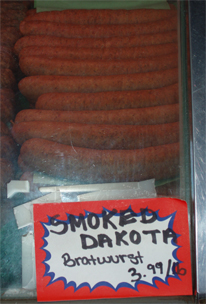
|
This particular store makes the Dakota sausages which is served in
great numbers to the Grape and Wine Festival which takes place in Lodi,
California each fall.
-------- The Mclntosh County German-Russians: The First Fifty Years Updated: 2-22-2007 By Gordon L. Iseminger North Dakota History, State Historical Society of North Dakota, Bismarck, North Dakota, Summer 1984, Vol. 51 No. 3, Pages 4-23 NDSU (North Dakota State University) http://www.lib.ndsu.nodak.edu/grhc/media/magazines/articles/mcintosh.html |
HISTORY
>>Sausage is a natural outcome of efficient butchery. Sausage-makers put to good use meat and animal parts that are edible and nutritious, but not particularly appealing, such as scraps, organ meats, blood, and fat, and allow the preservation of meat that can not be consumed immediately. Hence, sausages are among the oldest of prepared foods.
It is often assumed that sausages were invented by Sumerians in what is Iraq today, around 3000 BC. Chinese sausage làcháng (ÆcíÆ/¤Kƶ), which consisted of goat and lamb meat, was first mentioned in 589 BC. Homer, the poet of The Ancient Greece, mentioned a kind of blood sausage in the Odyssey (book 20, verse 25) , and Epicharmus (ca. 550 BC - ca. 460 BC) wrote a comedy titled The Sausage . Evidence suggests that sausages were already popular both among the ancient Greeks and Romans.[citation needed]
During the reign of the Roman emperor Nero, sausages were associated with the Lupercalia festival. The early Catholic Church outlawed the Lupercalia Festival and made eating sausage a sin. For this reason, the Roman emperor Constantine banned the eating of sausages. Early in the 10th century in the Byzantine Empire, Leo VI the Wise outlawed the production of blood sausages following cases of food poisoning.
Traditionally, sausage casings were made of the intestines of animals. Today, however, natural casings are often replaced by collagen, cellulose or even plastic casings, especially in the case of industrially manufactured sausages. Additionally, luncheon meat (such as SPAM) and sausage meat are now available without casings in tins and jars.
The most basic sausage consists of meat cut into pieces or ground and filled into a casing such as an animal intestine. The meat may be from any animal, but traditionally is pork, beef or veal. The meat/fat ratio is dependent upon the style and producer, but in the United States, fat content is legally limited to a maximum of 30%, 35% or 50%, by weight, depending on the style. The USDA defines the content for various sausages and generally prohibits fillers and extenders.[1] Most traditional styles of sausage from Europe and Asia use no bread-based filler and are 100% meat and fat (excluding salt and other flavorings, such as herbs).[2] In the UK and other countries with English cooking traditions, bread and starch-based fillers account for up to 25% of ingredients.
The word sausage is derived from Old French saussiche, from the Latin word salsus, meaning salted.<<
http://www.oscarenterprises.f2s.com/sausage_history.html
>>The manufacture of sausages began over two thousand years ago, and it is still a growing industry. While some of its basic practices are almost as old as civilisation, the industry is constantly adopting new developments in processing in the light of later scientific and technical knowledge.
Sausage has been an important item in man's diet for twenty centuries. The first recognisable mention of this meat food is found in a Greek play called "The Orya," or "The Sausage," written about 500 B.C. Thereafter the word for sausage occurs with frequency in Greek writings. It's also a favourite food of the Romans, at one time becoming so popular for festive occasions that it was placed under the ban of the early church.<<
http://www.3men.com/allyou.htm#Sausage%20History
>>The word sausage originally comes from the Latin word salsus, which means salted or preserved. In the days of old people did not have refrigeration to preserve their meat and so making sausage was a way of overcoming this problem.
Dry sausage was born as a result of the discovery of new spices, which helped to enhance, flavor and preserve the meat. Different countries and different cities within those countries started producing their own distinctive types of sausage, both fresh and dry. These different types of sausage were mostly influenced by the availability of ingredients as well as the climate.
Some parts of the world with periods of cold climate, such as northern Europe were able to keep their fresh sausage without refrigeration, during the cold months. They also developed a process of smoking the sausage to help preserve the meat during the warmer months. The hotter climates in the south of Europe developed dry sausage, which did not need refrigeration at all.
Basically people living in particular areas developed their own types of sausage and that sausage became associated with the area. For example Bologna originated in the town of Bologna in Northern Italy, Lyons sausage from Lyons in France and Berliner sausage from Berlin in Germany. <<
See this site for more information such as the "Basic Making Sausage Process"
WHAT'S COOKING AMERICA
http://whatscookingamerica.net/History/HamburgerHistory.htm
>>1209-1121 - Genghis Khan (1167-1227), crowned the "emperor of all emperors," and his army of fierce Mongol horsemen, known as the "Golden Horde," conquered two thirds of the then known world. The Mongols were a fast-moving, cavalry-based army that rode small sturdy ponies. They stayed in their saddles for long period of time, sometimes days without ever dismounting. They had little opportunity to stop and build a fire for their meal. The entire village would follow behind the army on great wheeled carts they called "yurts," leading huge herds of sheep, goats, oxen, and horses. As the army needed food that could be carried on their mounts and eaten easily with one hand while they rode, ground meat was the perfect choice. They would use scrapings of lamb or mutton which were formed into flat patties. They softened the meat by placing them under the saddles of their horses while riding into battle. When it was time to eat, the meat would be eaten raw, having been tenderized by the saddle and the back of the horse.
1238 - When Genghis Khan's grandson, Khubilai Khan (1215-1294), invaded Moscow, they naturally brought their unique dietary ground meat with them. The Russians adopted it into their own cuisine with the name "Steak Tartare," (Tartars being their name for the Mongols). Over many years, Russian chefs adapted and developed this dish and refining it with chopped onions and raw eggs.<<
Names of Stores You Recommend
Braunschweiger:
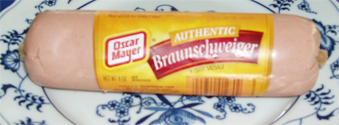 OSCAR
MAYER
OSCAR
MAYER
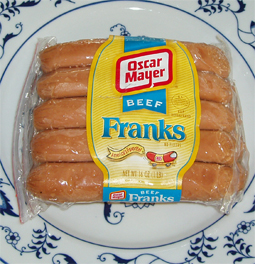 OSCAR MAYER's
Beef Franks
OSCAR MAYER's
Beef Franks

